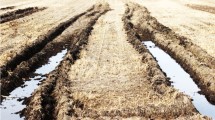Abstract
In the rice field methane is produced in the soil layer with depths of 2–25 cm. The vertical profile of methane production rate in the paddy soil during the water covering period differs from that in the paddy soil in dry phase. Only a small part, about 30%, of the produced methane is emitted to the atmosphere through rice plant, air bubbles, and molecular diffusion. Therefore, the methane emission rate from the rice field depends not only on the methane production rate in the soil, but also on the transport efficiency of the rice plant, air bubble formation that in turn depends on the production rate, and molecular diffusion.
Field measurements show that methane emission rates from a particular rice field have very large diurnal, seasonal and interannual variations, which are related to soil characteristics, water regime, farming procedure, local climate, and rice growing activities. The relationship between the methane emission rate and the above mentioned factors is very complicated. The emission rates from different rice fields differ greatly not only in the absolute value, but also in the temporal variation patterns.
Methane emission rate from the rice field may be significantly reduced by scientific management of fertilizer and irrigation. While the use of SO 2-4 containing fertilizer and fermented organic fertilizer may reduce the methane emission significantly, the most promising measure for reducing methane emission from rice field is the frequent drainage irrigation procedure.
Similar content being viewed by others
References
Dai Aiguo et al. (1991), CH4 emission from a Chinese rice field,Scientia Atmospherica Sinica,15(1): 102–110.
Schütz H. et al. (1989a), A 3-year continuous record on the influence of daytime, season, and fertilizer treatment on methane emission rates from an Italian rice paddyJ. Geophys. Res.,94: 16405–16416.
Schütz H. et al. (1989b), Processes involved in formation and emission of methane in rice paddies,Biogeochemistry,7: 33–53.
Sciler W. et al. (1984), Methane emission from rice paddies,Journal of Atmospheric Chemistry,1: 241–268.
Shangguan Xingjian and Wang Mingxing et al. (1993), Experimental study for methane production rate in rice paddy soilScientia Atmospherica Sinica, (in press).
Wang Mingxing et al. (1990), CH4 emission from a Chinese rice paddy field,Acta Meteorologica Sinica,4: 265–275.
Wang Mingxing et al. (1993), Sources of methane in China,Scientia Atmospherica Sinica,17(2): 52–64.
Author information
Authors and Affiliations
Rights and permissions
About this article
Cite this article
Mingxing, W., Xingjian, S., Renxing, S. et al. Methane production, emission and possible control measures in the rice agriculture. Adv. Atmos. Sci. 10, 307–314 (1993). https://doi.org/10.1007/BF02658136
Received:
Issue Date:
DOI: https://doi.org/10.1007/BF02658136




